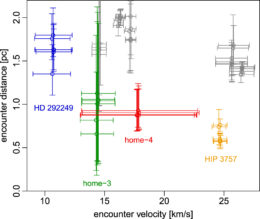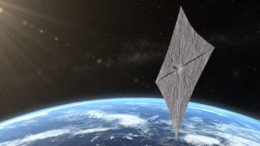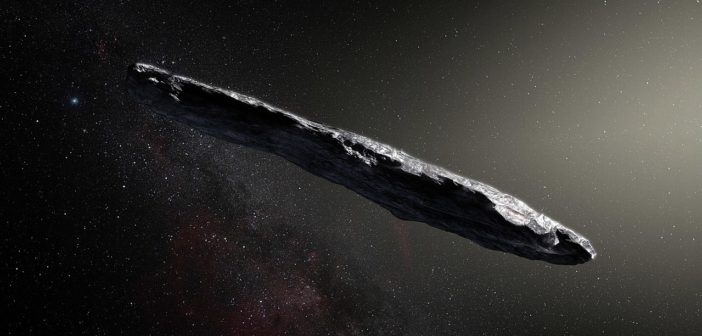’Oumuamua is back in the headlines again.
When the minor object 1I/2017 ‘Oumuamua was discovered in October of 2017, it was already speeding away from the Sun. ‘Oumuamua’s path, however, quickly identified it not as a solar-system body, but as an asteroid that originated from somewhere beyond our tiny corner of the universe.
Since ‘Oumuamua’s discovery, scientists have scrambled to interpret the bizarre observations of this body. For starters, ‘Oumuamua has an unusual shape: though we have no high-resolution images, light curves suggest that this tumbling asteroid is at least five times as long as it is wide. More recently, however, it’s ‘Oumuamua’s acceleration that has captured the attention of scientists.
Though the asteroid’s trajectory through our solar system was originally assumed to be solely governed by ordinary gravitational forces, recent research suggests that there’s something else at work. ‘Oumuamua’s motion can’t be explained by gravity alone; instead, the asteroid seems to be experiencing an additional acceleration away from the Sun that’s dependent on the Sun–asteroid distance.
What does some of the latest research say about ‘Oumuamua in light of this new development?
‘Oumuamua’s Origin

Encounter distance vs. velocity between ‘Oumuamua and the four main home candidate stars (plotted in blue, green, red, and yellow), for different models of ‘Oumuamua’s trajectory. [Bailer-Jones et al. 2018]
But the extra acceleration measured for ‘Oumuamua changes this picture. Past studies assumed that ‘Oumuamua was only influenced by gravity as it traveled, but a new study led by Coryn Bailer-Jones (Max Planck Institute for Astronomy, Germany) has traced its path backwards while also taking into account the asteroid’s observed extra boost.
The result? Using Gaia DR2 data, Bailer-Jones and collaborators found at least four plausible host stars for ‘Oumuamua within a few light-years, and future observations are likely to reveal additional candidates.

Image of comet 67P/Churyumov-Gerasimenko outgassing as it is heated by the Sun. Could similar processes be occurring on ‘Oumuamua? [ESA/Rosetta/MPS for OSIRIS Team]
Could ‘Oumuamua Be a Comet?
Though puzzling for an asteroid, the additional acceleration measured for ‘Oumuamua is naturally expected for icy comets. Comets passing near the Sun heat up, causing outgassing; this evaporating material then adds a boost to the body’s motion away from the Sun.
Observations of ‘Oumuamua contradicted the comet theory early on: there’s no observational evidence of outgassing, no coma or dust tails, and no cometary emission lines. But perhaps we just missed the signs, and ‘Oumuamua is somehow a comet in disguise?
That’s unlikely, according to author Roman Rafikov (University of Cambridge, UK and Princeton’s Institute for Advanced Study). In a recent study, Rafikov examined what would happen if ‘Oumuamua were outgassing like a comet. He found that, for reasonable assumptions about ‘Oumuamua’s properties, torques caused by outgassing would cause the body’s spin to evolve rapidly. This process would have spun ‘Oumuamua up to the point where it couldn’t hold itself together anymore, causing it to fly apart before it passed through our solar system.
How About a Giant Sail?
So if ‘Oumuamua’s acceleration can’t be explained by gravity, and it doesn’t seem likely that it’s outgassing, then what is causing the extra boost? Authors Shmuel Bialy and Abraham Loeb (Harvard-Smithsonian Center for Astrophysics) propose an alternative: solar radiation pressure. In a new study, Bialy and Loeb suggest that ‘Oumuamua could have an even more unusual shape than we initially thought: it may be tens of meters in surface area, but less than a millimeter thick.
Bialy and Loeb demonstrate that if this is true, the pressure of photons from the Sun pushing on this large surface could be enough to explain ‘Oumuamua’s extra acceleration, and they demonstrate that such a body could have survived interstellar transit without being eroded or broken apart.

Artist’s impression of an artificial light sail, a thin spacecraft that can be propelled by radiation pressure. [Josh Spradling / The Planetary Society]
The Puzzle Continues
So: is it aliens? Probably not, folks. But does ‘Oumuamua present a large number of puzzles that force us to continue to carefully employ the scientific method, evaluate possible uncertainties, and search for new explanations? Definitely.
We still have so much to learn about this bizarre asteroid. But in many ways, the puzzle of ’Oumuamua beautifully encapsulates the process of science — both in the excitement of an unsolved mystery and in the importance of critical thinking and methodical evaluation of possibilities.
Keep following along as our understanding of ‘Oumuamua continues to evolve!
Citation
“Spin Evolution and Cometary Interpretation of the Interstellar Minor Object 1I/2017 ‘Oumuamua,” Roman R. Rafikov 2018 ApJL 867 L17. doi:10.3847/2041-8213/aae977
“Plausible Home Stars of the Interstellar Object ‘Oumuamua Found in Gaia DR2,” Coryn A. L. Bailer-Jones et al 2018 AJ 156 205. doi:10.3847/1538-3881/aae3eb
“Could Solar Radiation Pressure Explain ‘Oumuamua’s Peculiar Acceleration?,” Bialy and Loeb 2018 ApJL, in press. https://arxiv.org/abs/1810.11490


3 Comments
Pingback: AAS Nova – New
Pingback: Mehr von diesem Blogger seit Ende Oktober | Skyweek Zwei Punkt Null
Pingback: Selections from 2019: Explanation for an Interstellar Visitor